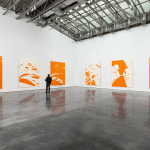
Contributed by Erin Yerby / Lauren Luloffs semi-transparent panels of silk, in their very stillness, betray a slight flutter of movement like a winged creature that flits from one form to the next. These windowed-openings onto swaths of spiraling color, seem to approach what Walter Benjamin described as the childs experience of color: color as the medium of all changes, and not a symptom.

Painting directly onto silk fabric, Luloff merges paint (here dye) with its support, perhaps in the spirit of Helen Frankenthaler, recalling her stain-soaking method and its variations. Whereas Luloffs previous body of work incorporated collage techniques, she considers this one more about purely painting. And indeed, the absorption of the dye into the material effects a merging of surface and background. For the beholder, this translates into an experience of being absorbed into color.

Sequences, the title of the show recently on view at Halsey McKay Gallery in East Hampton, hints at the tensed experience of movement-in-stasis. The vibrant series of panels, broken up by curtain-like striated narrower panels, propel the gaze forward. Viewing them, I returned to a dream I had once of being seated on a train in a state of intense immobility, frozen, while scenes of rapidly changing landscapes flitted by, scenes of my past become colors coalescing into barely recognizable shapes, each cinematically framed by the curtained window. And in my dream, the train wasn’t moving, not unlike the strange paradox of cinematic experience one has in viewing Luloff’s panels: entering a moving-image while standing still.


This could have been a Covid dream it echoes the many windows (real and virtual) that absorbed us during lockdowns and quarantines but it wasnt. Luloff’s sequences more broadly convey this sense of absorbed suspension, of hanging tensed between paralysis and movement. Fixed enclosures presenting window-like openings onto shape-shifting color-worlds, through which we might escape; each sequence a movement-image, propelled by tumbling letters and dramatized by the fluidity of the silk itself. Here, landscape perspective devolves towards a closer vision of blurred, fragmented micro-worlds, separated by playful plaid curtains.
Luloff says each sequence composes a story in its own right, and all the sequences are part of a larger, diaristic narrative within which each sequence could be other than it is, the story panels interchangeable, separable, reversible. As in storytelling, repetition transforms the content and often the order of the story, allowing new stories to emerge from unexpected associations.
The reversibility and substitution Luloff assigns to her sequences reflect the artist’s process, wherein refrains are carried over from one panel into others. The letters that appear in Luloff’s panels, especially Y (as well as W, F, and R) are refrains uttered under the breathsounds breathed by the artist across the surface of the painted field access points shaping the story, leading hand and eye toward what is not yet there, the future. At times, the letter becomes fleshy, like legs, as if to suggest the body-as-medium linking language and cosmos. While repeated sequences can simply establish a fixed relationship between parts, here the logic of repetition seems to serve a more mysterious process of divination.
“Lauren Luloff: Sequences,” Halsey McKay Gallery, East Hampton, NY. January 15 to March 20, 2021.
About the author: Erin Yerby writes, paints, and is a cultural anthropologist by training. She focuses on how invisible forcesgod(s), spirits but also affective historiesare rendered sensible in the body and other material mediations. Her dissertation (PhD Columbia University, 2017), Spectral Bodies of Evidence: The Body as Medium in American Spiritualism, is based on over three years of ethnographic fieldwork in Spiritualist communities in upstate New York and surrounds.
Related posts:
Eric N. Mack and Vivian Suter: How to fill a space
Interview: Lesley Dill on her new work, with Leslie Wayne























Unbelievable! Amazing work, fantastic writing with such a deep understanding of the artist�s idea and process.
I wish I could visit the gallery to meet and talk to the author.